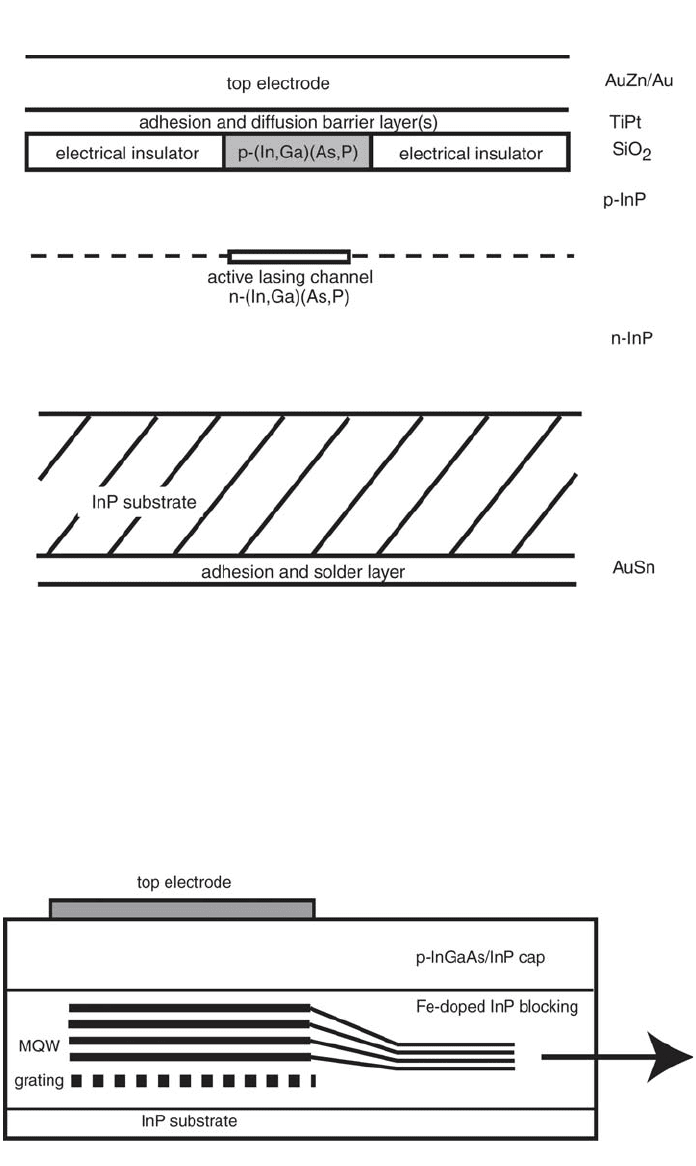Kutz M. Handbook of materials selection
Подождите немного. Документ загружается.


2 MATERIALS SELECTION FOR SELECT COMPONENTS 1311
Fig. 4 Unit cells of the Si (left) and InP (right, In - dark, P - light) structures.
materials discussed in the scientific literature for application to telecommuni-
cations is overwhelming. Only innovation will bring some of these exciting
materials into commercial use.
2.1 Packaging
A package can have many different functions: providing protection, distributing
power and signal, and dissipating heat.
9
The ability of a package to perform
these functions is dependent on the device as well as the materials properties
and design of the package. For example, devices with robust passivation and
protective layers may require a less robust package. Integrated circuits and de-
vices relevant to telecommunications contain layers of conducting, insulating,
and passivating layers, each with different criteria regarding protection from the
environment.
The telecommunications industry continues to grow, and its growth is enabled
by the ability to package its devices. Plastic packaging will play a major role in
its future. Oftentimes, however, packaging is a secondary consideration in the
development of silicon-based devices. Consequently, packaging has received far
less attention than warranted, given its crucial role in reliability, performance,
and cost. The tide is shifting as device fabrication continues to explore ways to
reduce cost and improve performance.
In order for optically interconnected systems to be manufactured realistically,
the packaging issue must be addressed for some telecommunication devices,
reliable packages have electrical and optical interfaces and must also be able to
withstand shock, vibration, and temperature variations. Ideally, these packages
are also of low cost.
Packaging is an area that is common to all forms of telecommunications:
cable, optical, and wireless.
Packaging Materials
A host of packaging materials is used in integrated circuits and thus telecom-
munications. They include metals, ceramics, plastics, and glasses. Packages that
are impervious to the environment (hermetic packages) are usually made from

1312 ADVANCED MATERIALS IN TELECOMMUNICATIONS
metal, ceramic, or glass materials; plastics make up nonhermetic packages. In
this section, we will survey packaging materials and their uses. Sample appli-
cations will also be discussed.
Ceramic Packages. Ceramic packages are laminate sheets of ceramic pow-
der made from a slurry of ceramic powder and a liquid binding mixture of
polymers and solvents. Sheets are cut into the appropriate size and via holes are
punched. These via holes are filed with metal powder and conducting traces of
metal powder are printed on the surface to form circuit patterns. These sheets
(as many as 30) are aligned and laminated. Additional circuit lines are metalli-
zed, and the leads to them are attached. As a whole, ceramic packages have
several benefits, which include hermaticity and the ability to sustain multiple
input/output ports. Alumina-based ceramic packages are ubiquitous in optoelec-
tronic devices due to superior radio frequency (RF) characteristics and high
reliability.
10
However, these packages have relatively high cost, poor dimensional
precision on firing, and a high dielectric constant.
11
Refractory Glass Packages. A lower cost alternative to ceramic is refractory
glass. Although glass has less complexity than laminate ceramic sheets, it is a
reliable and hermetic option. Typical glasses used are PbO–ZnO–B
2
O
3
types
with melting points near 400
⬚C.
11
Although hermetic, glasses can at times trap
moisture and impurities within the package and thus suffer imperfect reliability.
The combination of glass with lead frames made of Kovar (Fe–Ni alloy) has
been found to work well and makes up the technology known as CERDIP, which
denotes the used of ceramics (CER) in dual-in line packages (DIP). CERDIP
packages may use solder glasses which, specifically, are not glasses, but ceram-
ics.
Metals. Solders and their alloys
12
are commonly used for die attachment.
They include: tin,
13
tin–lead,
14
indium,
15
and gold eutectic alloys (with tin, silver,
or germanium).
16
In one approach, stable bonds of gold eutectic alloy solders
have been made with multilayers of alternating gold and tin.
17
Metals are also employed as diffusion barriers in laser die attachments to
reduce the unwanted development of intermetallic compounds.
17
Tungsten can
reduce the diffusion of gold from the die into indium solder. Nickel prevents
copper from diffusing into indium as well. To promote reliable bonds, wettable
layers are also used. Nickel–tin improves wetting of barrier layers to gold–tin
alloys. In addition, metals and semiconductor materials are used as heat sinks
in optoelectronic die attachment
17
and include materials such as copper, copper–
tungsten, silicon and silicon carbide, silver, and variations of each of these.
Metals (Al, Cu, Au, and their alloys) are also used for interconnection.
Plastics. The number of types and uses of polymers in packaging is for-
midable. There are excellent discussions of them in the literature.
9
Plastics may
be used as dielectric layers or adhesives and in constructing the body of the
moldings. In this section, we will explore them according to their function.
1. Large-scale integration requires insulating layers between metals. High-
temperature polymers serve as dielectrics between such layers and have
excellent planarization properties, making them well suited for integra-

2 MATERIALS SELECTION FOR SELECT COMPONENTS 1313
tion. Polyimides represent a class of materials used as interlayer insula-
tors. Usually spun-coated, they form conformal coatings with excellent
thermal and electrical properties. Their ability to form conformal shapes
also renders them useful in creating conformal coating layers as well.
2. Besides polyimides, silicon rubbers serve as conformal coatings. Silicon
rubbers are also used as encapsulate materials that are globbed on top of
devices and modules for protection. Other polymers that serve this func-
tion are Paralenes (poly-p-xylyenes), which are applied at low tempera-
ture through gas-phase polymerization and provide good electrical and
environmental performance.
3. In the manufacture of integrated chips, dies are separated from the wafer
and attached to the lead frame with adhesives. Solder bonding alloys and
organic adhesives are commonly used. Conductive polymers are a low-
cost alternative to gold containing solders and can be used in automated
processes. These compounds contain silver flakes that provide an elec-
trical path. Also, the molding package itself is polymer based. Often
coated with dielectric coating to provide electrical isolation, moldings are
made from epoxy resins, hardeners, fillers, catalysts, and colorant.
Case Studies
Semiconductor Laser and Optical Amplifier Packaging. Packaging has
many functions, as noted above, but in the optical arena, it also provides a means
of alignment of fiber arrays and/or laser diodes. Various ways of coupling optical
fiber to devices, optical alignment, and packaging approaches are discussed in
the literature
17
and will not be explored here. It is important to note, however,
that much work remains to be done in developing low-cost, precisely aligned
packages for integrated optical devices.
A number of thermal, mechanical, optical and electrical factors complicate
efforts to package lasers and amplifiers. Among these are the following: lasers
have high thermal sensitivity; many devices are sensitive to stress; device per-
formance is often dependent on the ability to suppress Fabry-Perot effects, and
parasitic electrical behavior of packages impairs device response.
17
For example, the connection of optical fibers to waveguide devices requires
precise fiber alignment, with lithographically etched fiber guides. Fibers are usu-
ally butted against the waveguide materials that lie adjacent to the active element.
These elements are held in place with solder bumps that provide alignment and
electrical connection. As describe above, many materials interplay in these pack-
aging assemblies underscoring the importance of selecting and designing them.
MEMS Packaging. The general sense of microelectromechanical systems
(MEMS) technologists is that MEMS packaging presents the greatest challenges
faced in the industry. To further complicate matters, packaging issues are appli-
cation specific and may not translate well from one device to another. As a
result, a few representative cases including telecommunications will be dis-
cussed.
Accelerometers are currently used in airbag deployment devices, but future
applications are on the horizon. In this device, long cantilever beams support a
massive beam. Along the beam are elements of a capacitor that sits between

1314 ADVANCED MATERIALS IN TELECOMMUNICATIONS
two fixed plates. Motion is detected when the spacing between these elements
changes. As one can image, in the case of an airbag, the performance of these
devices is vital. There should be no impediment to sensing deceleration. As a
result, hermaticity is imperative and has been achieved successfully with CER-
DIP hermetic packages.
18
Analog devices have developed a successful scheme
to precisely orient the package and maintain the sensitivity of the device.
Ink-jet technology, dubbed the first MEMS technology, requires a different
set of criteria. In this configuration, a heater element forms microscopic bubbles
that eject ink through a silicon-based nozzle. Here, a package must not block
the jets of ink, yet it must be protected from them. One approach is the creation
of a flexible circuit array bonded to the ink jets with a polymer.
Optical MEMS products add another layer of complexity, as access to the
outside environment is required. In these products a light path is commonly
needed to provide light to the ‘‘eyes’’ of the MEMS device. Although the re-
quirement seems simple, it is a complex task to achieve. As a result of these
rigid constraints, most optical MEMS systems require vacuum hermaticity to
ensure proper operation of the sensitive components.
Although MEMS packages are application specific, there are some common-
alities among them. For one thing, the device cannot be obstructed and must be
covered by a protective cap. Here, packaging occurs on the wafer level. Another
method of wafer level packaging is a method called ‘‘flip-chip.’’ It entails the
use of a silicon cap with circuitry bonded on top with an encapsulant. The
sealing is done by metallization (diffusion solder) or epoxy. An underfill is used
to fill the gap between the chips.
2.2 Solid-State Semiconductor Lasers
Advances in material properties have led to ubiquitous deployment of solid-state
lasers in CD players, barcode scanners, and optical communications. Specifi-
cally, lasers with output centered around 1.3 or 1.55
m have been prepared
using molecular beam epitaxy (MBE) and metal–organic chemical vapor dep-
osition (MOCVD) to deposit thin films of (In
1
⫺
x
Ga
x
)(As
1
⫺
y
P
y
) solid solutions,
hereafter referred to as InGaAsP.
19
The wavelength of the laser light can be
selected by choosing a desired lattice constant and then locating the proper
composition (Fig. 5). This allows the materials scientist to lattice match to a
particular substrate and tune to the operating wavelength, which is related to the
bandgap energy of the semiconductor. InGaAsP has been selected as the ideal
material for telecommunication lasers because of the following properties: (a) a
small direct bandgap that allows for efficient conversion of electrical energy to
light at the desired wavelengths, namely 1.28–1.62
m, (b) substrates of InP
grown by the Czochralski technique are commercially available, and (c) tech-
nology to form waveguides has been developed.
The microelectronics industry has migrated toward silicon-based devices,
even though GaAs demonstrates a higher electron mobility. However, neither of
these candidates possess the qualities of InGaAsP. Specifically, silicon possesses
an indirect bandgap that prohibits the radiative recombination of electron-hole
pairs. Further, GaAs with superior electrical performance and a direct bandgap
emits light in the visible spectrum when doped with aluminum. For this reason,
(Al,Ga)As devices are found everywhere as red light-emitting diodes and lasers;

2 MATERIALS SELECTION FOR SELECT COMPONENTS 1315
0
0.5
1
1.5
2
2.5
5.6 5.65 5.7 5.75 5.8 5.85 5.9 5.95 6 6.05 6.1
lattice constant (Å)
bandgap (eV)
InAs
InP
AlAs
GaAs
Fig. 5 Bandgap and lattice parameter as a function of composition
for (In
1⫺x
Ga
x
)(As
1⫺y
P
y
) solid solutions.
however, the bandgap energies required for telecommunication are much lower.
Therefore, all of the processing steps that were developed for Si and GaAs
devices were duplicated for InP chemistry.
State-of-the-art telecommunications systems use 80 wavelengths separated by
50-GHz spacings. Control of the MOCVD growth conditions for solid-state la-
sers is paramount for a reliable process where layer thicknesses can deviate by
only a few angstroms. The typical InGaAsP thin-film stack to fabricate a laser
cavity are illustrated in Fig. 6. Transmission electron microscopy (TEM) of an
InP semiconductor laser clearly shows layer thickness and grain structure and
also indicates quality of epitaxial films as seen in Ref. 20.
Many functionalities have been incorporated into solid-state lasers, which has
been reviewed in detail for telecommunication applications.
21
The materials used
in these laser devices are all similar, yet the device designs are radically different.
The goal is to integrate as many functionalities as possible while keeping reli-
ability high and cost low. For example, distributed feedback (DFB) lasers can
produce continuous-wave light at a very specific wavelength, which is required
for DWDM since the channel spacing is only 50 GHz. Further, due to the chro-
matic dispersion of optical fiber, the spectral width of the laser emission is
minimized to avoid broadening of the light pulse during propagation in the fiber.
A narrow spectral width is accomplished by fabricating a Bragg grating beneath
the laser cavity (Fig. 7). The laser cavity is a multilayer quantum well (MQW)
structure that provides higher gain, a lower threshold, and lower losses.
Electroabsorption modulated lasers (EML) are an integrated laser and mod-
ulator on an InP substrate. Current devices can operate at 10 GHz, and research
is pushing the modulation rate to 40 GHz. Further integration is achieved in
wavelength-selectable lasers with gain, and modulated intensity are being de-

1316 ADVANCED MATERIALS IN TELECOMMUNICATIONS
Fig. 6 Semiconductor laser cross section with emitted light from
the buried channel active region.
Fig. 7 Cross section of a distributed feedback (DFB) laser.
veloped (Fig. 8). For this device, each DFB laser produces continuous-wave light
at a specific wavelength. The system selects which laser to activate; then that
light passes through the combiner and into a semiconductor optical amplifier
(SOA), which boosts the intensity, after which the light is modulated by the
electronic data stream. High-performance laser packages, which monitor output

2 MATERIALS SELECTION FOR SELECT COMPONENTS 1317
Fig. 8 Schematic top view representation of a wavelength selectable laser.
Fig. 9 Basic schematic of a high performance laser package.
from the laser cavity, can actively control the wavelength of the device by chang-
ing the temperature of the InGaAsP laser chip. The typical materials used in a
solid-state laser package are illustrated in Fig. 9. The major assemblies include
an InP substrate with InGaAsP laser, a thermoelectric cooler with feedback loop
to control temperature, an isolator made by a Faraday rotator and polarizers (see
Section 2.8), spinel and glass lenses, an etalon to monitor the wavelength of the
laser output, and a photodetector to monitor light output from the back facet,
and heat sink subassemblies. The subassemblies are attached by soldering and
wire bonding. The assembly is mounted in an alumina-based hermetic ceramic
package. Finally, the fiber is aligned and the steel ferrule is laser welded. The
future challenges for higher performance solid-state laser devices are immense.
22
2.3 Photodetectors
Two main types of photodetectors are used in telecommunications: pin (p-
intrinsic-n) and APD (avalance photodiodes).
23
APDs are a high-performance
ultrafast photodetector that provide gain for weak signals. APD devices are ex-
pensive; therefore, if use of pin photodiodes is possible, it is the preferred choice.
In addition, APD detectors require large biases on the order of 50 V, whereas
pin devices usually are biased about 5 V. Again as in solid-state semiconductor
lasers, the materials are chosen based on bandgap and ultimately on quantum
efficiency. For telecommunications, the chosen materials are based on solid so-

1318 ADVANCED MATERIALS IN TELECOMMUNICATIONS
Fig. 10 Light guided down a water stream demonstrating principle of internal reflection of
light.
lutions of InGaAsP on InP. To improve device performance, a lattice match with
the substrate is desired in order to minimize the dark current and thus improves
the signal-to-noise ratio of the device.
Additional improvements can be made by appropriate metal contacts. The
choice for metal contacts on semiconductors can be an art. For example, AuGe/
Ni has been used on InP and TiAu on In(As, P).
24
The selection of a metal
contact is initially made depending on the doping state of the semiconductor.
The work function (
) of the metal needs to be less than the work function for
n-type and greater than the work function for p-type semiconductors in order to
make an ohmic contact. The work function is defined as the difference between
the Fermi energy and the ionization energy.
2.4 Optical Fiber
The principle of guiding light within a medium is not new. In 1854, John Tyndall
demonstrated that a stream of water could guide light.
25
In his experiment, a
light shines through a stream of water jetting out from the side of a tank of
water would and bends along the stream’s path (see Fig. 10). The stream of
water successfully guides light until the turbulence of the stream’s surface made
the beam more diffuse. The water guides the light by internally reflecting it.
That is, the light at the water/air boundary is reflected back into the water.
Internal reflection occurs only when going from a material of high refractive
index (water) to a material of lower refractive index (air).
26
Today we have more sophisticated means of guiding light, one of which is
through the use of optical fibers. Optical fibers are narrow strands of glass,
polymers, or a composite of both. One of the early identified challenges of
guiding light through a single medium, such as glass, is that light leaks whenever
the medium contacts materials other than air, that is, material with a refractive
index greater than air. The solution to this problem was addressed by making a
fiber ‘‘sandwich,’’ placing an outer cladding layer around the fiber core. In this
manner, light travels along the fiber core confined by the lower refractive outer
layer. This arrangement not only confines the light but also prevents leaks should
the fiber touch materials that are more highly refractive (see Fig. 11).

2 MATERIALS SELECTION FOR SELECT COMPONENTS 1319
Fig. 11 Light guided in an optical fiber by total reflection in the high refractive core bounce
back by the low refractive cladding.
The majority of fibers are made from glass consisting of silica (SiO
2
)or
silicate. Glass fiber properties have a range that suits both short- and long-haul
transmission. Plastic fibers are used less widely and are limited to short distances
but can withstand more abusive environments due to greater mechanical tough-
ness compared with glass. In the design of optical fibers it is important to con-
sider the loss or reduction of signal as it travels in the material. Sources of loss
in silica fibers are absorption from impurities, absorption due to molecular vi-
brations, and scattering by fiber atoms.
27
These losses can be resolved by re-
ducing the number of impurities, as well as by optimizing the material’s
dispersion and tailoring the chemical composition to create graded refractive
indexes. For the silica fiber, the chromatic dispersion is near zero at 1.33
m
and has its lowest attenuation at 1.55
m.
28
In the next following sections we will examine the materials used in optical
fiber and their fabrication.
Glass Materials
Glass optical fibers are nearly always vitreous silica doped with small amounts
of germanium oxide (GeO
2
), phosphorus oxide (P
2
O
5
), or fluorine, but can be
mixtures of oxides, sulfides, and selenides
29
that create a random covalent net-
work. Unlike ordered crystalline materials, there is no well-defined pattern and
accordingly no well-defined melting point.
30
The largest class of optical fibers
is made from oxide glasses, in particular silica (SiO
2
), with a refractive index
of 1.458 at 850 nm.
31
The refractive index of a material may be changed by
controllably adding impurities or dopants. Such dopants include fluorine and
metal oxides. Inclusion of GeO
2
or P
2
O
5
increases the index, whereas the inclu-
sion of fluorine or B
2
O
3
decreases the refractive index.
31
Silica’s properties make it a formidable candidate for optical fiber due to its
low thermal expansion, high transparency, and high resistance to thermal shock.
However, the high melting point needed for its fabrication from the molten form
gives rise to the need to explore alternative low-melting-point silicates. These
materials include soda-lime silicates, borosilicates, and germanosilicates. Soda-
lime silicate glasses are combinations of silica, alkaline oxides (such as Na
2
O
or LiO
2
) and other oxides (MgO, ZnO, or BaO).
31
As a result, these materials
are easy to melt and fabricate into fiber.
In some cases it is necessary to boost the signal periodically due to attenuation
and losses. The signal can be amplified by doping the fiber with erbium. The
EDFA (erbium-doped fiber amplifier) has proven to be an enabling technology

1320 ADVANCED MATERIALS IN TELECOMMUNICATIONS
for optical communication.
32
A pump laser at 0.98 or 1.48
m excites the erbium
atoms, which transfer their energy an additional 1.55
m light waves by laser
action to amplify the weakened signal.
27
The ƒ-orbital transition in Er
3
⫹
yields
the amplification around the 1.5-
m band used for long-haul telecommunication.
The promise of a low-cost alternative to the EDFA is the EDWA (erbium-doped
waveguide amplifier). An advantage of EDWAs is the ability to be integrated
with other optical components due to the fabrication of the waveguide on a
silicon optical bench.
To increase the channels, it is necessary to extend the bandwidth beyond 1.5
m. Presently, a combination approach of rare-earth doped fiber amplification
and Raman amplification is employed.
27
Another variation of the structure of optical fiber is the development of pe-
riodically varying index in the fiber core, called a fiber grating.
33
By selectively
transmitting wavelengths and reflecting others depending on the pattern spacing,
these fibers can be modified to act as mirrors, sensors, filters, or resonant cavi-
ties.
34
Plastic-Clad Fibers
For short data transmission ranges (several hundred meters) where high losses
are tolerable, plastic-clad fibers are an inexpensive alternative. The fibers are
composed of silica cores with lower refracting plastic cladding made of silicone
resin (with an index of 1.405 at 850 nm) or perfluoronated ethylene propylene
(Teflon) (with a refractive index of 1.338). Only used for step-indexed fibers,
the core diameters are larger (150–600
m) than conventional all-glass cores
and cladding systems and permit low-cost interfaces with light sources and de-
tectors.
Plastic Fiber
For short distances (maximum 100 m) an all-plastic multimode step-index al-
ternative may be used.
35
Although they have significant signal losses, they are
tough and durable and thus do not require special handling. High refractive
differences between core and cladding make this an attractive alternative for
short haul applications, but costs are still high. Core and clad combination of a
polystyrene (index 1.6) core and methyl methacrylate (index 1.49) cladding have
been demonstrated.
31
Fabrication of Optical Fibers
All-glass optical fibers are made of extremely pure silica glass. The cladding is
made of the purest material, while the core material includes deliberately and
precisely controlled amounts of impurities (which increase its refractive index).
Two common methods are used in the manufacture of all-glass optical fibers
34
:
They are direct-melt processes and vapor-phase oxidation processes.
In the direct-melt method, the optical fiber is made directly from molten
silicate glass. Two concentric platinum crucibles, one for the core and one for
the cladding, are filled with the appropriate molten glass. A fiber is then drawn
from the orifices at the bottom of the crucibles, rendering a continuous drawing
process.
31,34
Despite the relative ease of this manufacturing technique, careful
